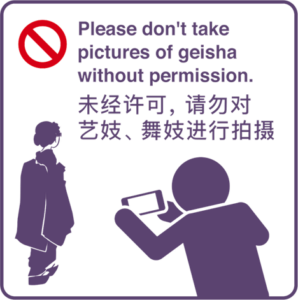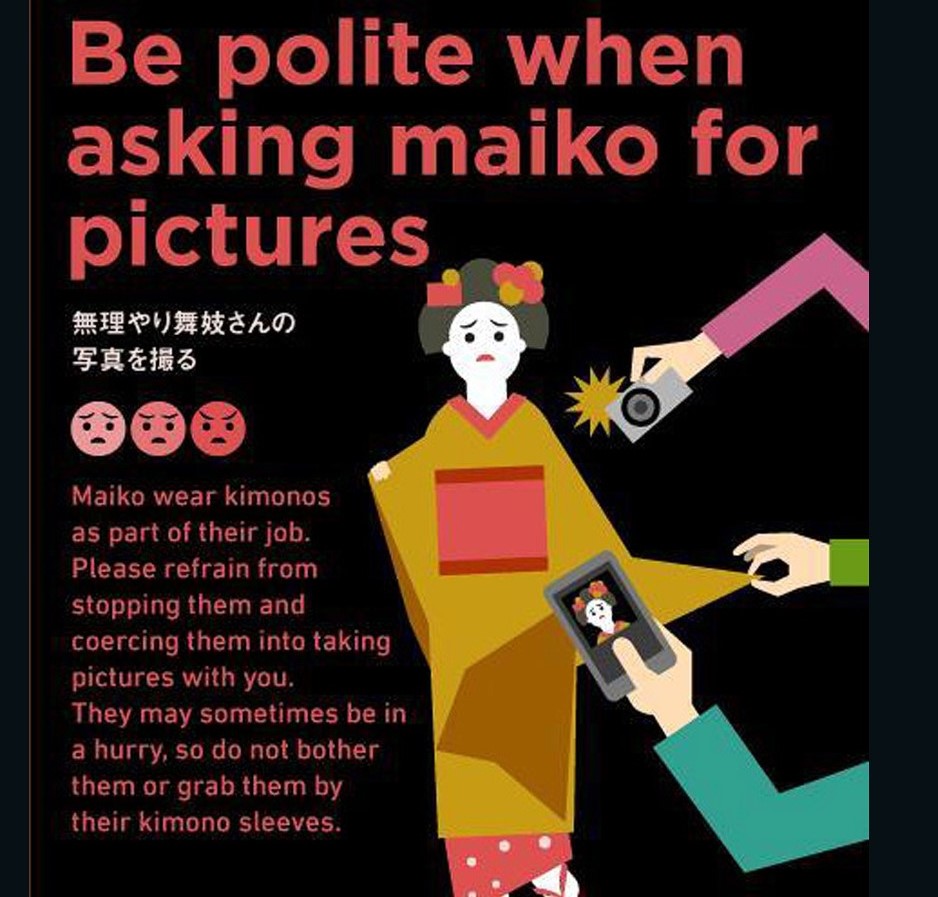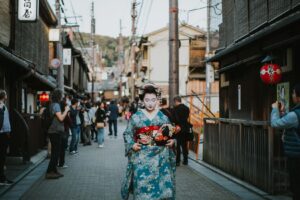Catching sight of a maiko off to an assignment in formal costume offers an “only in Kyoto” experience. This enthusiasm has led to the hanamachi (geisha neighborhoods), especially Gion Kōbu, becoming tourist areas.
But this successful promotion of the maiko as Kyoto mascot has led to tourist enthusiasm almost impossible to manage.
Some tourists demand selfies. Others engulf maiko with flash photography. Videos show tourists crowding around maiko or running ahead to snap photos of maiko coming toward them. Day and night. Tourist exuberance became so intense that maiko had to take taxis to go even a short distance.
How should a maiko respond to tourist paparazzi?
Artist Koyama Aiko takes up the problem in her popular manga, now an NHK-World Japan anime. This manga frame shows the shikomi (trainee) Riko accompanying maiko Momohana to an evening assignment. Riko scowls at the rude tourists. But Momohana, celebrated as a perfect maiko, never loses her poise. Although Riko gets scolded by an elder for her “bad attitude,” I think Koyama depicts her anger sympathetically in this episode. (See Maiko Masquerade, 137; Koyama, Maiko-san-chi, Vol. 6, 65-74).
As a maiko in the late 1960s, Iwasaki Mineko experienced her share of harassment on the street, too. In those days before Gion became a tourist site, Iwasaki had to fight off unruly, drunk men. She had to run away from men trying to grab her. One even “dropped a live cigarette butt down the nape of my kimono (190).” Iwasaki fought back–yelling and even biting one harasser’s hand until it bled. She, too, finally had to “travel everywhere by taxi, even if my engagements were only a few hundred feet apart (191).
How has Kyoto tried to help the maiko?
In 2020, of course, the pandemic caused a sharp decline in tourism. Will the “tourist paparazzi” problem resume in the post-pandemic? What measures were taken to curb the problem?
Gion deluged by tourists
In 2019, TBS News carried a report (in Japanese) on maiko harassment by tourist paparazzi: Tourists from abroad flooding into Gion are disturbing the quiet charm of the neighborhood. One café owner complains that tourists stand outside his shop trying to take photos of maiko through the windows. Some even open the door and go inside to get the picture. The report is careful not to single out any particular nationality of tourists. Some scenes show respectful tourists quietly listening to their guide, but this is still viewed as a nuisance.
Signs of the Times
Kyoto tried posting manners signs. Signs sprung up around Kyoto tourist areas warning tourists “not to touch the maiko.” The Kyoto City Official Travel Guide, among its five tips for enjoying Gion, cautions tourists about taking photos of maiko and geiko. (Note that in English, this warns against objectionable behavior to “geisha” but in Chinese, uses “maiko” (舞妓).

“Maiko, who can be said to be a symbol of Gion, is a practice in the daytime and a repetition of work at night. It’s a busy day, and it ’s not uncommon to have many requests, especially at night. When they see Maiko in Gion, they are on their way to work. Let’s not disturb them.” PHOTO: https://kyoto.travel/en/info/manner.html
Kyoto also initiated a smartphone app in 2019 that cautioned tourists, once they stepped foot in Gion, to mind their manners: “Show good manners in Gion. Gion is a residential area. Please behave with courtesy.”
They also hired individuals (the tape shows these are older men) who can speak English or Chinese to patrol the area, asking tourists to move on, stop taking photos, and generally trying to keep order.
In 2019, taking photos in small residential alleys in Gion was banned.
In 2021, Gion and other hanamachi are likely more concerned about bringing tourists back to the districts and their shops and cafes. Let’s hope when tourists come back, everyone respects the maiko.
Featured Image: This section of a poster on manners comes from the Kyoto City Official Travel Guide
https://kyoto.travel/en/info/enjoy-respect-kyoto/akimahen.html
Reference
Iwasaki Mineko and Rande Brown. Geisha, a Life. Translated by Rande Brown. Atria, 2002.
Jan Bardsley, “Don’t Harass Maiko,” janbardsley.web.unc.edu. March 12, 2021
I designed this website and blog for educational and informational purposes only. I strive to locate the names of the creators of texts and images cited, and properly acknowledge them.




I love signs in Japan. There’s always such an effort to make them understandable even beyond words! But sometimes the results are amusing. Still, those poor maiko!
I feel sorry for maiko. But also I imagined that the presence of paparazzi make maiko more “maiko rashii maiko”…interesting!
Thanks, Haruka and Rebecca, for posting your ideas. I remember reading a beauty guide that advised readers to “pretend paparazzi are following you every time you leave the house” (or something like that). That way, the reader would feel important and make an effort to look smart. Maybe we need a sign that says, “Don’t look now, but paparazzi may be following you.” Jan